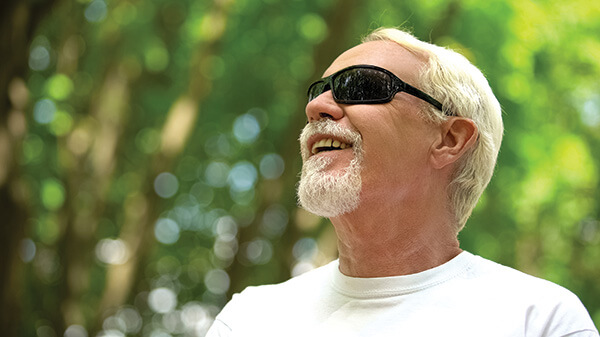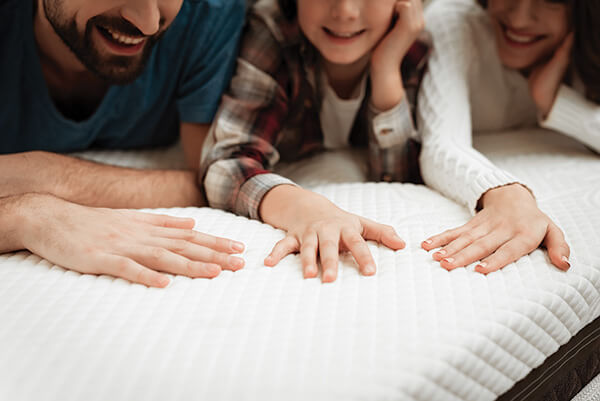Turn your store a delight for the eyes, ears, skin, nose and even mouth to give customers an experience they can’t find online
Consumers increasingly live in a screen-centered world, waking up to alarms on their phones, reading the news on that same tiny screen, maybe hopping on a computer for work and then unwinding in front of another screen for that evening’s entertainment. Little screen. Medium screen. Big screen. So many screens.

And while those screens stimulate (and probably overstimulate) our eyes, that doesn’t do much for the rest of our senses. Humans exist in a rich and varied world, full of interesting sights, sounds, smells, tastes and textures.
Gretchen Rubin says she finds herself locked in a world of screens — and her own thoughts. Rubin, author of bestselling books including “The Happiness Project” and “The Four Tendencies,” is at work on a new book about the five senses.
“I was drawn to this subject, in large part, because I’m so unaware of what’s going on around me. I very easily get lost in my own thoughts, and I don’t notice the sights, sounds, smells, tastes and textures of the world,” she wrote in a recent blog. As part of the writing and research process, she’s immersing herself in experiences that are designed to appeal to all of her senses.
Tired of the isolation of the Covid-19 pandemic, many consumers are like Rubin, eager for experiences — travel, concerts, sporting events, parties. Even shopping.
They have gotten too accustomed to the ease and convenience of shopping online to give it up, but there are times when they want to browse stores, see and touch products, and interact face-to-face with a helpful retail sales associate.
Better Sleep Council research released last year found that even with interest in online shopping continuing to grow, 87% of consumers would visit a brick-and-mortar retailer to purchase a mattress. “Brick-and-mortar retailing retains its pre-eminent position in mattress buyers’ minds,” says Mary Helen Rogers, vice president of communications and marketing for the International Sleep Products Association. The BSC is the consumer education arm of ISPA.
So, now more than ever, brick-and-mortar retailers need to reward in-store shoppers with a delightful sensory experience that makes it worth leaving their houses and putting down their screens for a while.
Let’s look at ways you can enliven your brick-and-mortar stores, appealing to all five senses.
Sight

If you want to freshen your decor or give the walls a fresh coat of paint, consider verdant greens and gray greens from the plant world.
Their eyes are going to give most shoppers their initial impression of your store, whether they first encounter your brand online or when driving by your stores. So, keep your brand identity sharp: There should be strong visual links between the colors, logos and imagery you use online and in-store.
Curb appeal matters as much at retail as it does in a residential neighborhood, even if you can’t control the exterior of your store the same way you can the outside of your house, especially if you rent space. Your signage should be in good repair and brightly lit; your windows clean and uncluttered by too many promotional materials. Planters with evergreens or seasonal flowers add warmth and hominess to what can be sterile commercial exteriors.
Inside your store, keep in mind some of the same principles interior designers use in residential spaces: group items in eye-pleasing odd numbers (3, 5, 7, etc.), create a few focal points around the store, and layer items so that your showroom floor isn’t a broad expanse of nothing but flat rectangles. For merchandising ideas, read SleepSavvyMagazine.com/All-About-the-Products from the September/October 2021 issue.
Pro tip: If you want to freshen your decor or give the walls a fresh coat of paint, consider verdant greens and gray greens from the plant world — the kinds of organic, grounding shades that help to bring the outdoors inside. Or choose a buoyant blue, perhaps an airy hue reminiscent of the sky, or a midtone blue that’s soothing and peaceful. Paint companies and other color forecasters chose those as the hot hues for interiors in 2022.
Touch
This is the sense most likely to drive consumers into bedding stores: They want to touch and feel sleep products for themselves before buying. Even the most thoroughly crafted product descriptions, inviting photos and compelling customer reviews can’t compete with rest-testing a mattress.
Suppliers do their part by creating soft, textural fabrics that invite shoppers to touch them as they compare bed models. Many of the latest cooling technologies create a cool-to-the-touch feel. Be sure to point that out to shoppers and let them experience it firsthand. Those sumptuous, functional fabrics will get covered up by linens later, but they’ll help make the sale.
And, speaking of linens, be sure your accessories displays make it easy for shoppers to feel the fabrics of protectors, sheets and other top-of-bed items — all the products that will be closer to their skin on a nightly basis. Use displays of sample products and fabric swatches (particularly handy for sheets) to encourage shoppers to touch and compare materials.

Be sure your accessories displays make it easy for shoppers to feel the fabrics of protectors, sheets and other top-of-bed items.
Retailers who start rest-testing with a pillow fitting know that the practice helps not only to boost pillow sales but also to ensure customers are happy with their mattress purchase. With the proper pillow in hand — and under head — shoppers’ bodies will be better aligned while trying different mattresses. And, as any RSA who has watched shoppers hug a test pillow to their chests knows, pillows offer customers a bit of emotional comfort, too.
Pro tip: Shoppers sometimes struggle to imagine what a mattress and adjustable base combo will feel like. If you can’t blanket the entire showroom with power bases, pair them with the models you use most frequently for rest-testing and also with your bestselling beds. In this case, feeling is believing.
Smell
The aroma of coffee in the morning. The scent of a grandparent’s house. Smells can instantly bring back memories and evoke emotions. People who lost their sense of smell through a bout of Covid-19 can attest to how much we rely on our sense of smell to navigate the world, and how much we miss it when it’s gone.

Above all, you want your store to smell clean.
Above all, you want your store to smell clean. Use air purifiers to vent strong food smells out of areas where employees eat, and use vents and fans to keep bathrooms smelling fresh. A Sleep Savvy contributor once read a tip for speed cleaning before party guests arrive: Swipe a few surfaces near the door with lemony Pledge or the windows with Windex. People immediately register these scents as “clean.” Daily cleanings of a store’s front door and sales desk can have the same olfactory effect.
If you want to layer another fragrance on top of the “clean” smell, you can invest in electric or reed diffusers, aromatherapy sprays or well-attended candles to lightly scent the air. If you have a display of these same items for sale, even better. When a customer says, “It smells so good in here. What is that?” you can direct them to the spray or diffuser and add it to their bedding purchase.
Even though you’re selling sleep products, stay away from scenting the store with relaxing smells like lavender. You want shoppers eager to buy, not ready to curl up for a nap. Instead, try stimulating scents — rosemary, eucalyptus or any of the citruses (orange, lemon, grapefruit, yuzu) — that will energize shoppers. You can switch scents seasonally, for instance, using peppermint, cinnamon or pine during winter months and switching to jasmine or lemongrass in the summer.
Many people are sensitive to strong smells, so you don’t want to heavily scent your store. A subtle fragrance is pleasant.
Pro tip: Stock aromatherapy sleep products. Blu Sleep, a sleep products manufacturer based in Pompano Beach, Florida, offers foam pillows infused with scents such as lavender, chamomile, lemon verbena and sandalwood. Malouf, a bedding and furniture company with headquarters in Logan, Utah, offers aromatherapy sprays to pair with its Zoned ActiveDough memory foam pillows infused with lavender, chamomile and peppermint. At the Winter Las Vegas Market, Cleveland-based bedding producer Rize rolled out a Rize Essentials line of sleep accessories, including diffusers, essential oils and candles, as well as sleep masks, silk pillowcases and other items. “How can mattress retailers not be in this business?” asked David Jaffe, chief executive officer, during market. Sleep Savvy wonders, too.
Hearing
There are times when even the busiest, most successful bedding stores grow quiet, and for shoppers who may be rest-testing mattresses, silence can make an already awkward process even more uncomfortable.
That’s one reason it’s nice to have music playing softly in the background. You may want to avoid blasting local radio stations — unless you have your own radio spots running — because the ads can be distracting and jangle sensitive shoppers’ nerves. Ad-free music streaming subscriptions are relatively inexpensive and will give you plenty of options.
But what to play? Cloud Cover Music, a provider of music to retailers and other corporate clients based in El Segundo, California, says in a blog post your overall brand identity is “the most important element when choosing what genres of music to play.” Are you a high-end specialty bedding store serving affluent consumers? Do you specialize in natural products? Do you do a volume (pardon the pun) business with customers ages 35-55? Each type of store should choose a different soundtrack.

Experiment with different
soundtracks to see what
boosts sales and keeps
RSAs’ energy up.
Time of day matters, too. “For example, when people get off work, they may prefer more relaxing music,” the company recommends, “but if they shop in the morning, they may want something peppier and happier to keep them awake.”
As with scents, shy away from music that’s too soothing. A drowsy shopper is more likely to stop shopping and go home to sleep on their own mattress than to go through with making a major purchase.
Experiment with different soundtracks to see what boosts sales and keeps RSAs’ energy up.
Pro tip: In describing the ideal bedroom, the BSC reminds consumers that “reducing noise in your bedroom can help you sleep and will make the room feel more welcoming.” The BSC suggests people add fans, air purifiers or small fountains to their bedrooms. You can stock a small assortment of these, along with white noise machines. Sleep Savvy looked into white noise machines in an article about helping your customers create the ultimate bedroom. Check SleepSavvyMagazine.com/The-Ultimate-Bedroom-Makeover from the January/February 2021 issue to read more.
Taste
Sticky fingers and dark beverages don’t mix well with pristine mattress fabrics but you still can appeal to bedding shoppers’ sense of taste. On warm days or if shoppers have been browsing awhile, offer cold bottles of water or iced tea — and provide napkins to keep condensation from dripping. To kick off Memorial Day sales, bring out the lemonade.

Supply delivery teams with
individually wrapped chocolates
or mints to leave on new
mattress sets.
You also can add a bowl of individually wrapped peppermints or other candies to the sales desk or near the door for a sweet treat shoppers can pop in their mouths to celebrate their bedding purchase.
And don’t forget to supply delivery teams with individually wrapped chocolates or mints to leave on new mattress sets after they finish the in-home setup. It’s an inexpensive gesture that will make customers feel like they’re checking into a luxury hotel for the night. They’ll sleep well and remember you made the extra effort.
Pro tip
The next time you host an event at your store, whether it’s a special sale or a drive for a local charity, partner with a food truck or two (maybe one that offers savory dishes and one that specializes in sweets) and
give your customers a deal on their dishes. It’s a nice surprise for shoppers and popular food trucks have followings that could help introduce new customers to your business.

